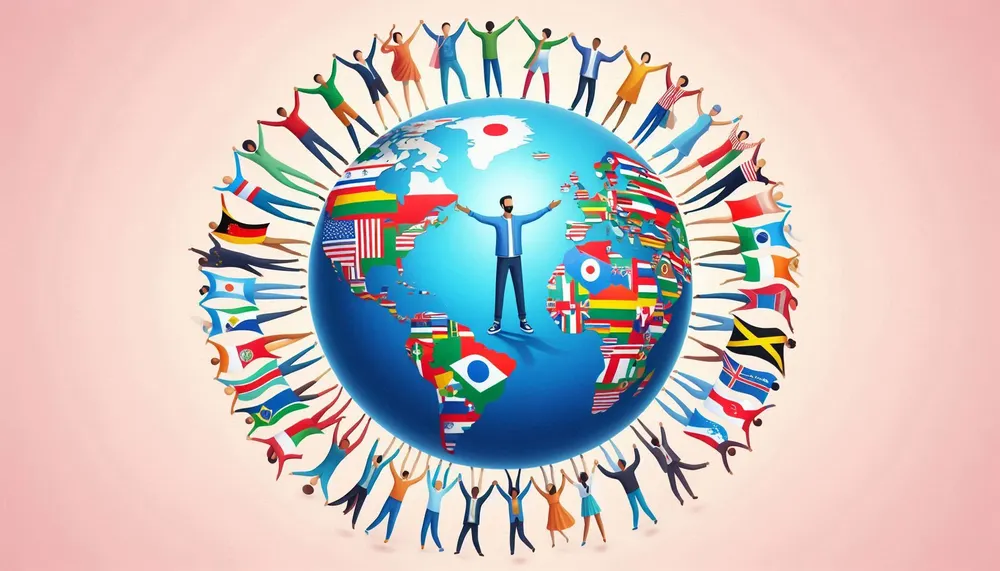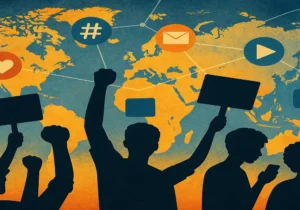Cultural Globalization Explained: Erosion vs. Evolution of Local Identities
Cultural globalization refers to the exchange and assimilation of ideas, customs, and values across different cultures, driven by advancements in communication, travel, and technology. It leads to increased interconnectedness, blending cultural practices, and the spread of global cultural phenomena.
In this article, we will explore cultural globalization’s impact on local cultures, examining whether it leads to cultural erosion or evolution. We also discuss globalization’s mechanisms—such as homogenization, hybridization, and localization—and analyse the benefits, risks, and examples of cultural exchange.

Introduction: How Cultures Evolve and Adapt
Cultural globalization is a powerful force reshaping societies worldwide, leading to the increasingly interconnected nature of cultural norms, traditions, values, and practices across borders. This phenomenon has accelerated due to advancements in communication, trade, travel, and digital technology, creating a global “melting pot” where different cultures influence and interact with one another. However, this integration has sparked debate regarding its impact: does cultural globalization lead to the erosion of unique local cultures, or does it catalyze their evolution?
The question hinges on understanding how global exchange affects cultural identity, language, heritage, and traditions. Let’s explore the key factors contributing to cultural globalization, its effects on local cultures, and the debate surrounding cultural erosion versus cultural evolution. In doing so, we can better appreciate both the risks and opportunities that cultural globalization presents.
What is Cultural Globalization?
Cultural globalization refers to the worldwide exchange and adaptation of cultural elements such as ideas, lifestyles, media, values, and goods. Unlike economic or political globalization, which is primarily concerned with trade and governance, cultural globalization focuses on the dissemination of cultural products and practices. Its rapid expansion has been fueled by advancements in technology, global media conglomerates, social media, and international trade, creating platforms for the mass distribution and consumption of cultural content.
The agents of cultural globalization are varied, including:
- Media and Entertainment: Global media companies, such as Disney, Netflix, and YouTube, produce and distribute content consumed by people around the world, contributing to shared cultural references.
- Technology and Social Media: Platforms like Instagram, Facebook, TikTok, and Twitter enable the instantaneous sharing of cultural expressions, allowing for a rapid exchange of ideas across borders.
- Trade and Commerce: The global marketplace promotes cross-cultural consumerism. Brands like McDonald’s, Starbucks, and Nike adapt their products to local markets, blending global appeal with regional flavors.
- Migration and Travel: The movement of people across borders for work, education, or tourism facilitates cultural exchange, as individuals introduce their customs and traditions to new places.
These factors collectively shape a complex global culture, integrating elements from various parts of the world.
Mechanisms of Cultural Globalization
Cultural globalization operates through several primary mechanisms that influence how cultures evolve or diminish over time:
- Cultural Homogenization: This refers to the process by which diverse cultures become more similar due to the dominance of certain cultural expressions. Often driven by Western media and brands, cultural homogenization can lead to a “monoculture” where local traditions are overshadowed by global influences.
- Cultural Hybridization: Hybridization is the blending of different cultural elements to create new, unique forms. This can be seen in food (e.g., fusion cuisine), music (e.g., K-pop’s blend of Western and Korean influences), and fashion, where global and local elements coexist and evolve together.
- Cultural Imperialism: Cultural imperialism occurs when one culture dominates others, often as a result of historical colonization or current economic power. Western media, fashion, and language are frequently seen as dominant, shaping aspirations and behaviors around the world.
- Localization: While globalization has introduced foreign elements to local markets, these elements are often localized to align with regional preferences. For example, fast-food chains like McDonald’s adapt their menus to suit local tastes in different countries.
Through these mechanisms, cultural globalization presents a dynamic interplay of both integration and resistance, leading to questions about how it impacts traditional cultures.
The Erosion of Local Cultures: Risks and Challenges
Critics argue that cultural globalization often leads to the erosion of local cultures, homogenizing diversity, and leading to the gradual disappearance of cultural distinctiveness. This cultural erosion can manifest in various ways:
a. Language and Linguistic Diversity
One of the most visible effects of cultural globalization is the decline in linguistic diversity. English has emerged as the global lingua franca, leading to a decrease in the use of indigenous languages. UNESCO estimates that one language disappears every two weeks, primarily due to a lack of transmission to younger generations. The dominance of English in business, science, and entertainment places many languages at risk, as younger generations opt to learn global languages for better job prospects and social mobility.
b. Traditional Practices and Beliefs
Globalization’s emphasis on a modern, consumer-driven lifestyle can undermine traditional practices and beliefs. This is particularly evident in communities with strong cultural identities, where younger generations may perceive local customs as outdated. In many indigenous societies, for instance, traditional knowledge related to agriculture, medicine, and spirituality may be sidelined in favor of Western education and values.
c. Loss of Cultural Heritage
Cultural heritage—historical sites, festivals, art forms, and rituals—is an essential aspect of cultural identity. The increasing standardization of global culture threatens these heritage assets. For instance, traditional arts, handicrafts, and performing arts may struggle to compete with mass-produced global entertainment. Additionally, local festivals and rituals can be commercialized for tourism, transforming authentic cultural expressions into consumer experiences, which can erode their original significance.
d. Consumerism and Identity Shifts
Global brands influence personal and societal values, promoting a consumer-driven lifestyle that can overshadow traditional community-focused values. For example, the spread of fast-food chains and Western fashion brands has impacted food practices, diets, and dress codes worldwide. As people, especially youth, adopt globally popular products and behaviors, traditional practices may be replaced, leading to an identity shift that aligns more closely with global standards than with local heritage.
The Evolution of Local Cultures: Benefits and Opportunities
Proponents of cultural globalization argue that, rather than eroding local cultures, it provides an opportunity for cultural evolution. This view sees globalization as a vehicle for enriching cultural diversity through exchange and innovation.
a. Cultural Hybridization and Innovation
Cultural globalization fosters a blending of cultural elements, resulting in hybrid forms of music, art, cuisine, and fashion. For instance, the popularity of K-pop is a testament to how local cultures can borrow elements from global music genres (pop, hip-hop, R&B) to create something new and uniquely Korean. Fusion cuisine, combining ingredients and techniques from different culinary traditions, is another example of how globalization can lead to cultural innovation.
b. Revitalization of Traditions
Globalization has also led to renewed interest in preserving cultural heritage. Increased awareness of cultural diversity has encouraged efforts to protect endangered languages, promote indigenous art, and safeguard cultural practices. Digital technology plays a significant role here, allowing cultural groups to document and share their traditions with a global audience, creating opportunities for preservation and revival.
c. Access to Cultural Exchange and Learning
The Internet and social media provide unprecedented access to information, enabling individuals worldwide to learn about and appreciate different cultures. This exposure can foster intercultural understanding, tolerance, and appreciation. For example, people can attend virtual tours of museums worldwide or participate in language exchange programs online, gaining insight into diverse ways of life without leaving their home country.
d. Economic Empowerment through Cultural Exports
Cultural globalization also allows local cultures to reach international markets. Artists, artisans, filmmakers, and designers from various countries can now showcase their work globally, reaching a broader audience. The popularity of African fashion, Japanese anime, and Latin American music illustrates how local cultures can capitalize on global markets, gaining recognition and economic benefits.
Case Studies: Cultural Globalization in Practice
Examining specific examples can highlight the contrasting outcomes of cultural globalization, showing both risks and benefits.
a. The Influence of American Pop Culture
American pop culture, including Hollywood films, fast-food chains, and fashion, is one of the most significant forces in cultural globalization. American media heavily influences global pop culture, leading to widespread adoption of American-style consumerism and lifestyle choices. While this can lead to the homogenization of culture, it also demonstrates how one culture’s elements can achieve worldwide recognition and popularity.
b. The Globalization of Yoga
Yoga, with roots in ancient Indian culture, has become a global phenomenon, adopted and adapted across cultures. This global popularity has led to the commercialization of yoga, with variations like power yoga and goat yoga straying far from traditional practices. However, it has also raised awareness of Indian spirituality and wellness, with many people around the world embracing meditation, mindfulness, and wellness practices rooted in Indian traditions.
c. Japanese Culture’s Global Appeal
Japan has successfully promoted its pop culture internationally, with anime, manga, and J-pop enjoying global fanbases. This cultural export has not only bolstered Japan’s economy but also increased global awareness and appreciation of Japanese traditions, from martial arts to tea ceremonies. Japan’s success demonstrates how a country can leverage globalization to share its cultural heritage, blending traditional and modern elements to engage a global audience.
Striking a Balance: Cultural Preservation and Global Integration
The challenge of cultural globalization is to balance integration with preservation. There are several strategies that can support this balance:
- Cultural Policies and Education: Governments can play a role in preserving cultural heritage through policies and programs that support traditional arts, languages, and practices. Schools and universities can also incorporate local history, language, and customs into their curricula, instilling a sense of cultural pride.
- Supporting Local Arts and Media: Funding and promoting local media, art, and entertainment industries can help counterbalance the influx of foreign culture. By providing platforms for local creators, countries can promote diverse cultural expressions that reflect their unique identities.
- Community Engagement and Empowerment: Communities must be empowered to preserve their cultural heritage. Local festivals, museums, and cultural centers are essential for maintaining cultural traditions and providing a space for younger generations to engage with their heritage.
- Encouraging Intercultural Dialogue: Promoting respectful exchange between cultures allows for mutual appreciation and understanding, reducing the likelihood of one culture dominating others. International cultural exchange programs, festivals, and forums can facilitate this dialogue, fostering an environment where cultures coexist and enrich one another.
Conclusion
Cultural globalization presents both opportunities and challenges for local cultures. While it has the potential to homogenize diverse traditions, it also allows for cultural exchange, innovation, and revitalization. Whether cultural globalization results in the erosion or evolution of local cultures depends largely on how societies respond to the pressures and opportunities it brings.
Ultimately, a balanced approach that values both global integration and cultural preservation can help foster a world where diverse cultures not only survive but thrive. Embracing globalization’s positive aspects while safeguarding cultural heritage is crucial for nurturing a rich, diverse, and dynamic global society.





